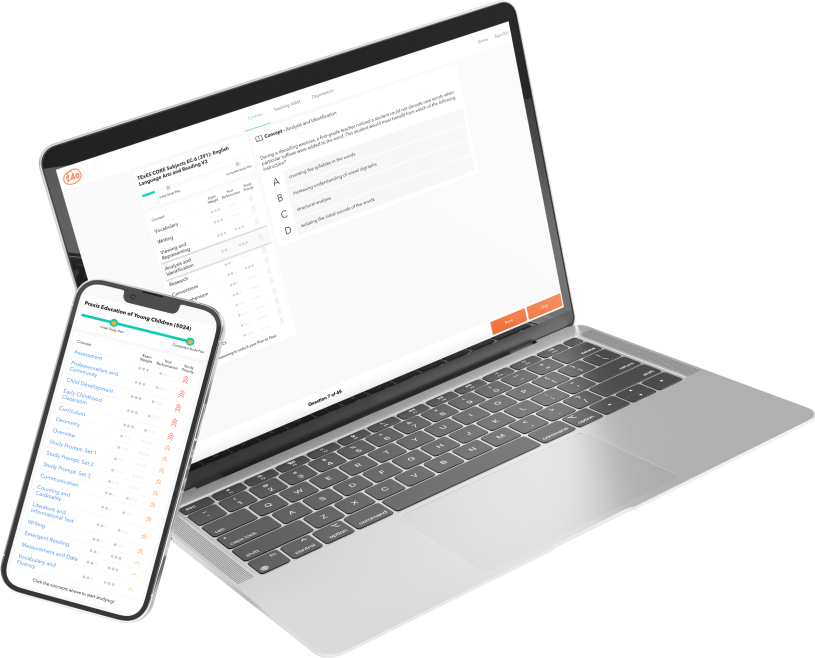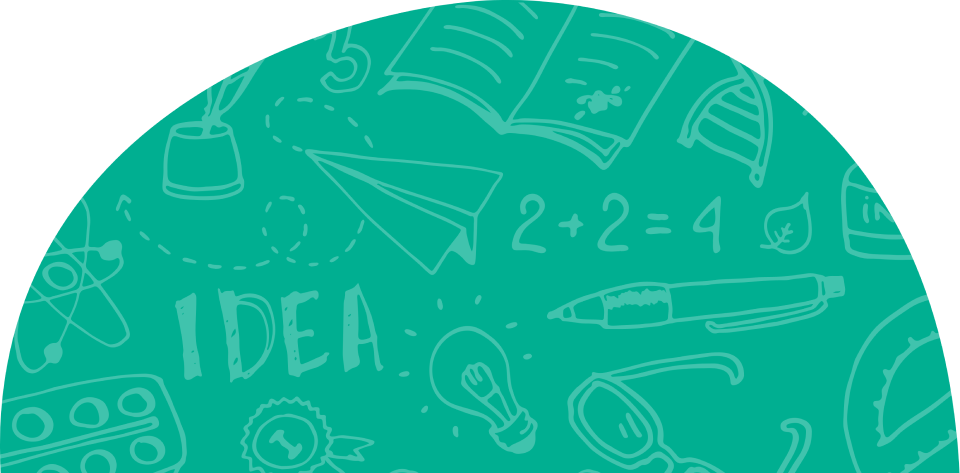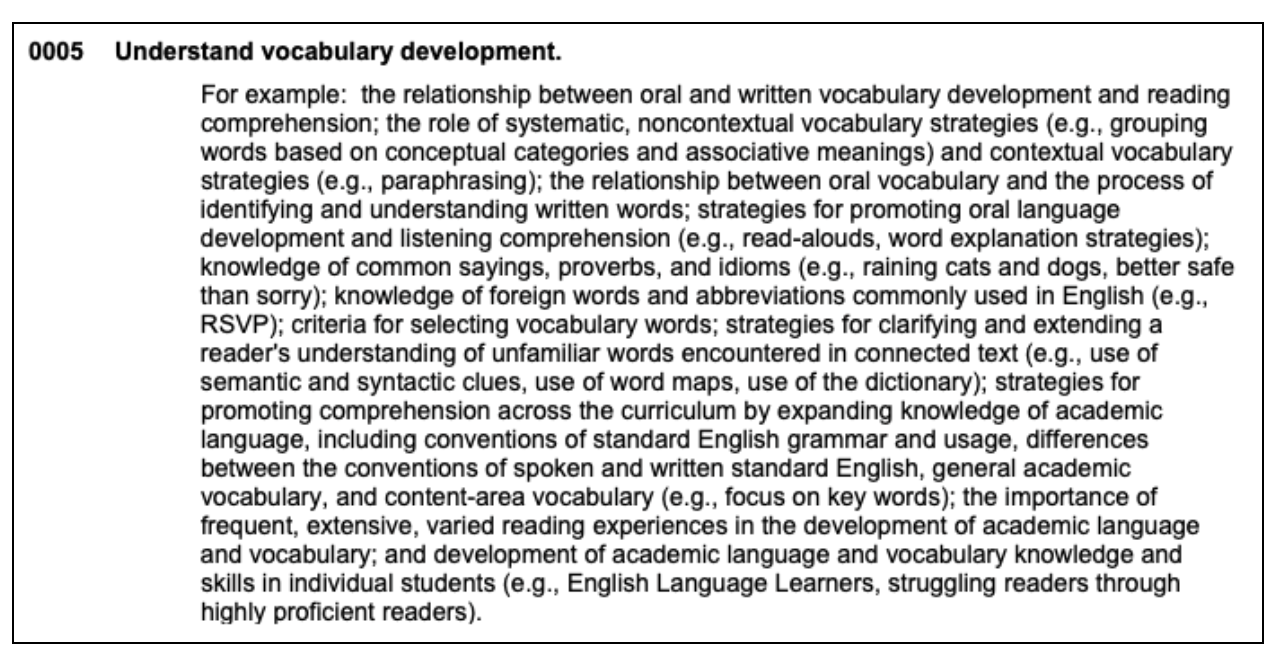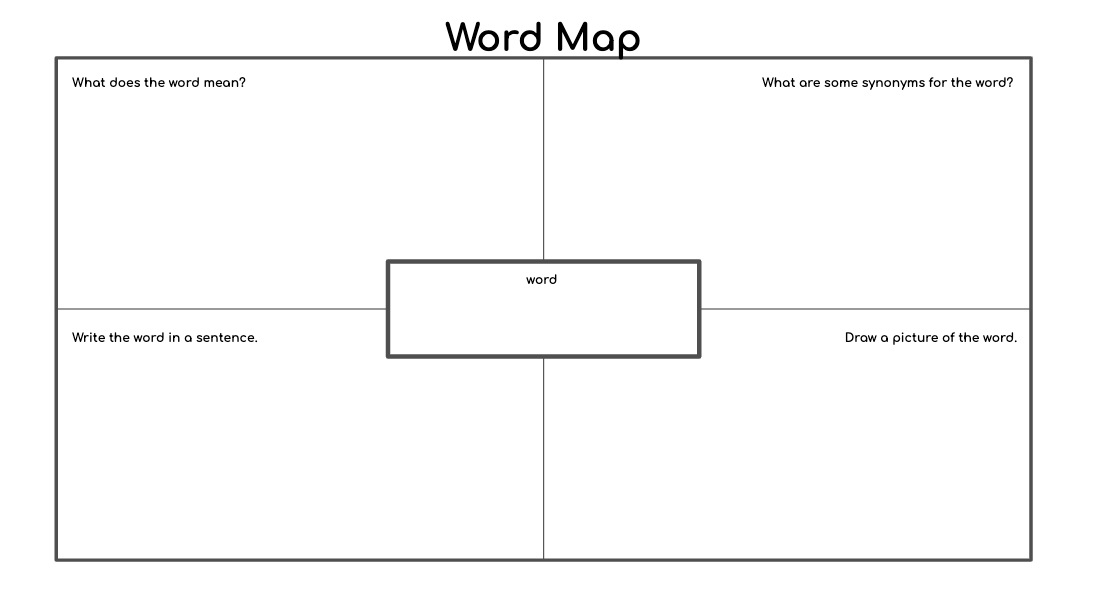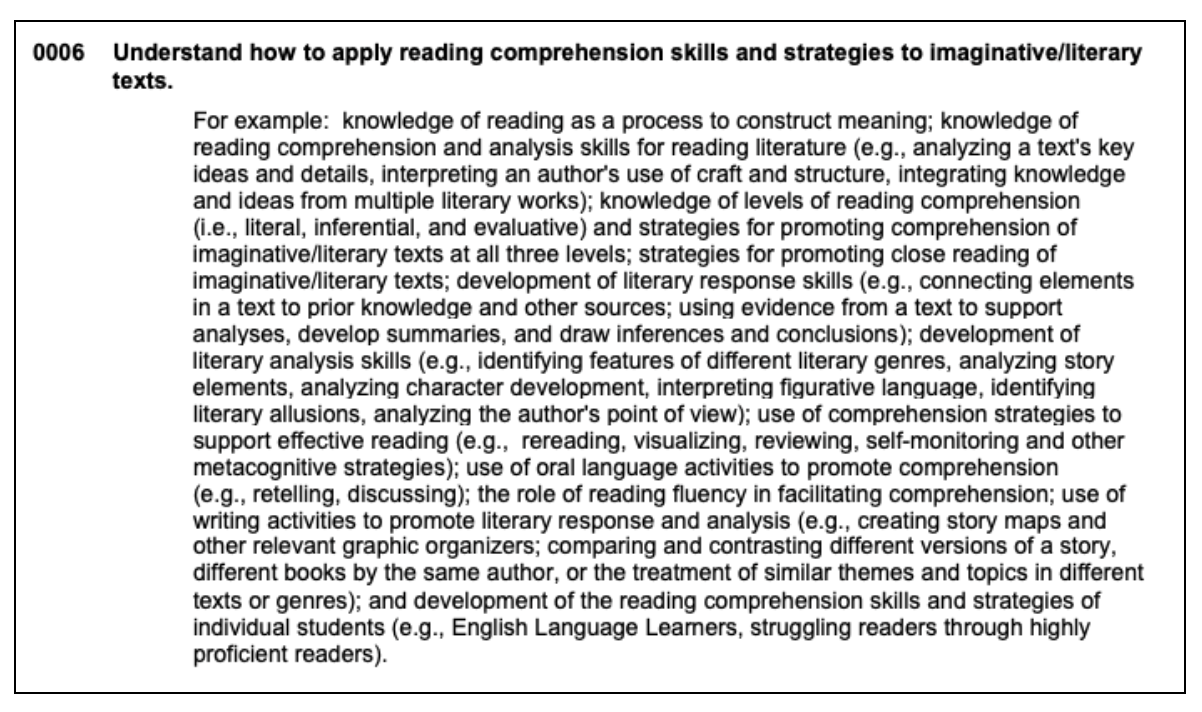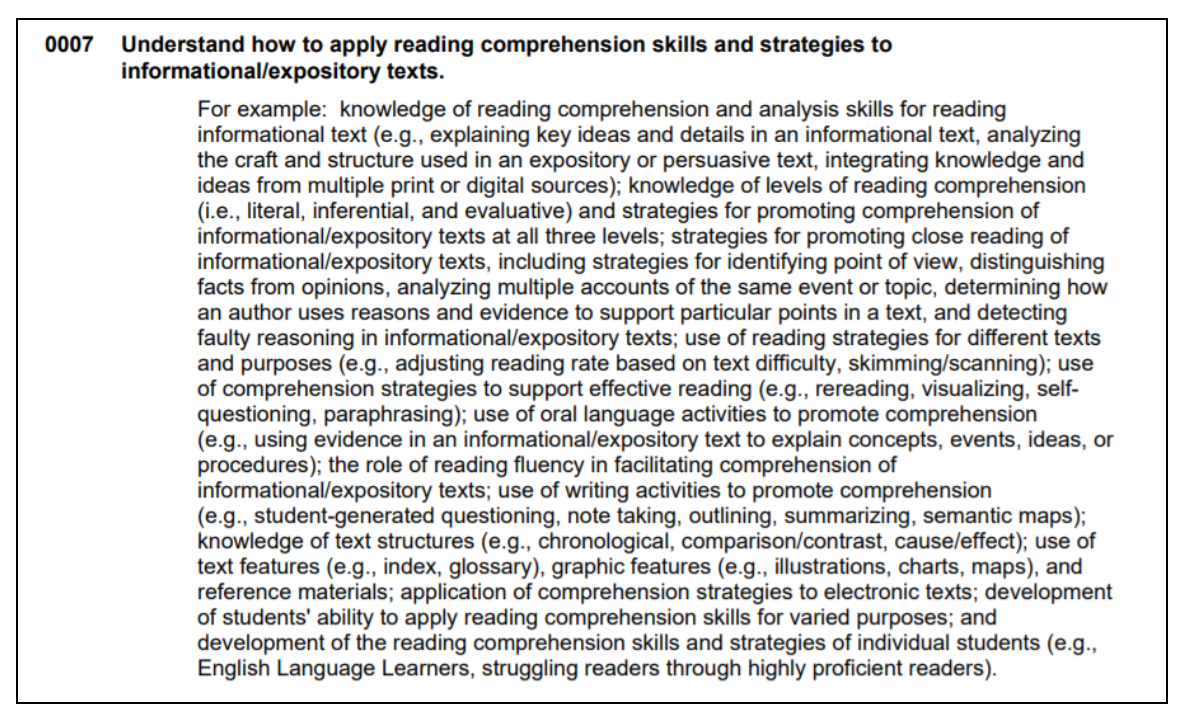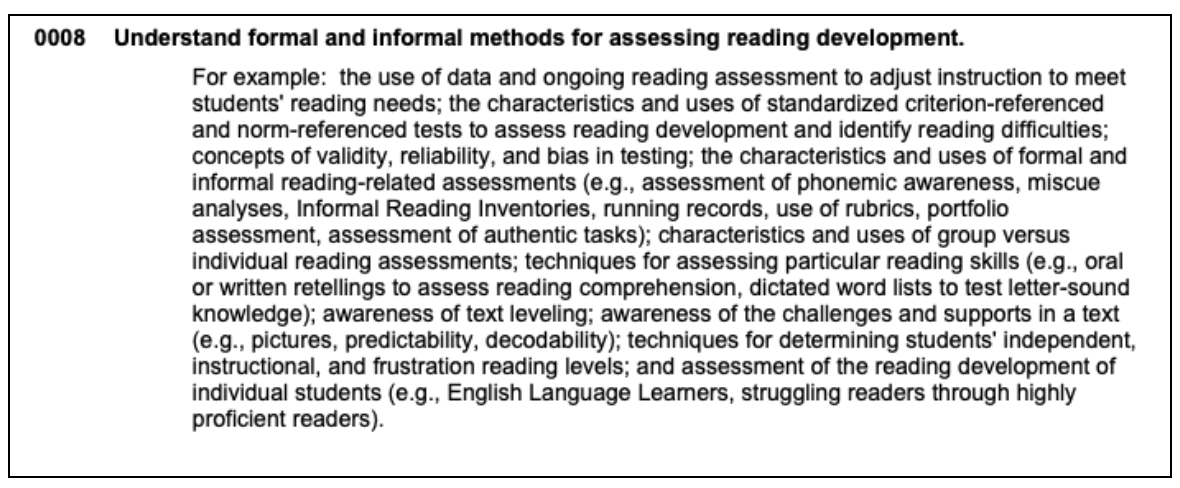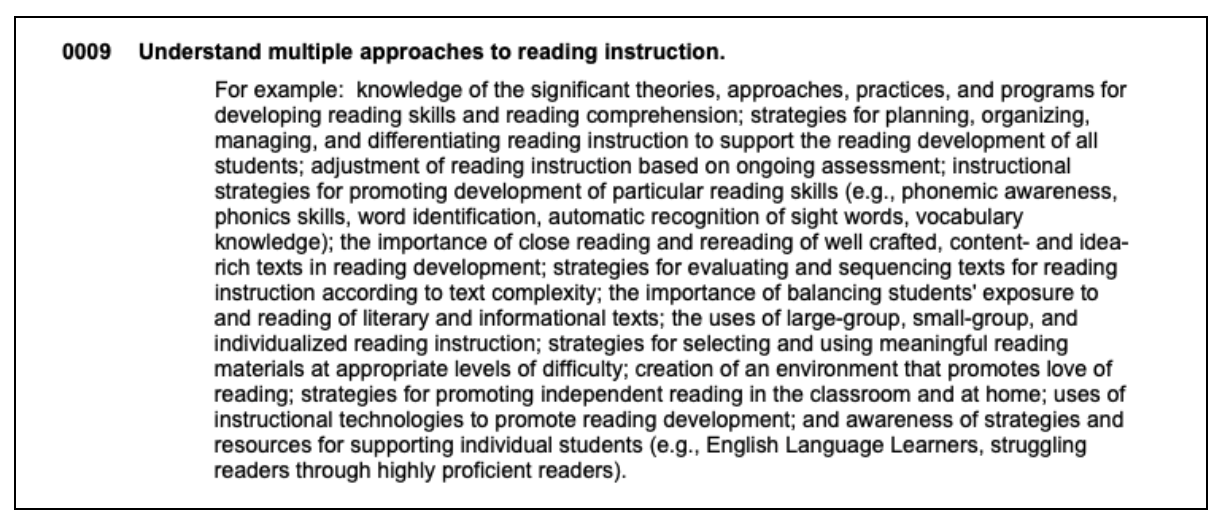Preparing to take the Wisconsin Foundations of Reading exam?
Awesome!
You’ve found the right page. We will answer every question you have and tell you exactly what you need to study to pass the exam. Find our Wisconsin Foundations of Reading practice test above.
Quick links to help you navigate.
Wisconsin Foundations of Reading Overview
The Wisconsin Foundations of Reading exam assesses reading instruction knowledge and skills. It is a required exam for licensure for all elementary teachers and reading specialists.
Format:
Cost:
$139
Scoring:
Candidates applying for Wisconsin licensure must score 240 or higher to pass the test. Your score is based on the number of items you answer correctly across all subareas and is converted to a scale that ranges from 100-300.
You will receive a report that details your performance for both multiple choice and open-response items. These results will help you identify areas of strengths and weaknesses, but there are no passing scores for individual subareas; passing status is based only on your total test score.
Data from the 2015-2016 year shows that out of 4,804 tests taken, there was a 55% pass rate. 66% of test takers passed after their first attempt, and 39% passed after their second attempt.
Subarea I: Foundations of Reading Development
Subarea I accounts for about 35% of the multiple-choice section of the exam.
This subarea has four objectives:
- Phonological and Phonemic Awareness
- Concepts of Print and the Alphabetic Principle
- Phonics
- Word Analysis
So, let’s start with Phonological and Phonemic Awareness.
Phonological and Phonemic Awareness

This section tests your ability to understand phonological and phonemic awareness. This includes but is not limited to:
- the distinction between phonological and phonemic awareness
- the role of phonological and phonemic awareness in reading development
- the difference between phonemic awareness and phonics skills
- levels of phonological and phonemic awareness skills
- strategies to promote phonemic and phonological awareness skills
Let’s discuss some concepts that will more than likely appear on the test.
Phonological Awareness
Phonological awareness is the ability to recognize and work with sounds in spoken language. It is
an essential skill that lays a foundation for reading success.
Phonological awareness is a broad concept that can be broken into different components. The components include:
- how sentences can be broken into words
- how words can be broken into syllables
- the onset/rime structure of words (for the word “cat,” the onset is “c” followed by the rime “at”)
Reading actually starts when children tune into the sounds of spoken words; this is why phonological awareness is vital to a child’s reading success.
During the most formative stages, children will be able to pick out rhyming words and count the number of syllables in a name. They will also be able to notice how sounds repeat themselves (alliteration). For example:
Susie sold six salami sandwiches.
In its more developed stage, phonological awareness moves from
noticing
to
doing
. Children can now come up with rhyming words, and they can break words apart into syllables or single sounds.
Phonological awareness instruction should include:
- Explicit instructionbefore and during reading instruction
- Modelingeach activity when it is first introduced and being sure todemonstrate
how to say different sounds as students watch the formation of the teacher’s mouth
- Guided practice and reviewto help students learn skills
- Prompt error correctionso students are not allowed to practice errors
- Individual assessmentsto determine which students are at risk for difficulty in learning to read
- A range of different types of activities
- Using concrete objectslike blocks, counters, puppets, picture cue cards, etc.
Phonemic Awareness
Phonemic awareness is the ability to notice, think about, and work with individual sounds in spoken words. Instruction in phonemic awareness involves helping children recognize and work with phonemes. The ability to recognize that words are made up of specific sounds, and that those sounds can be manipulated, is essential to success in learning to read.
Here are developmentally appropriate stages of phonemic awareness instruction:
- Develop an awareness of sounds
- Blend two words from a prompt (foot + ball → football)
- Blend one-syllable words from a prompt (/c-a-t/ → cat)
- Recognize similar sounds (/ch/ in chair and /ch/ in chew)
- Break apart one-syllable words (bat → /b-a-t/)
- Isolate the initial sound of a word (identify /d/ as the first sound in door
)
- Change the initial sound to create new words (bat → sat, cat, that
)
- Isolate the final sound of a word (identify /
k/ as the final sound in clock
)
- Change the final sound to create new words (hat → had
)
- Isolate the middle vowel sound (identify /a/ as the middle sound in cat
)
- Blend two-syllable words (/r-o-c-k-e-t/ → rocket)
- Rhyme one-syllable words(cat, bat, sat, pat)
Blending
Blending is the skill of joining sounds (phonemes) together to make a spoken or written word. Blending is a specific phonemic awareness skill that should be taught early on in reading instruction (see steps above). Blending is essential for reading so that words can be decoded effectively. Here is an example of blending:
/c-a-t/ → cat
This section tests your ability to understand phonological and phonemic awareness. This includes but is not limited to:
- the distinction between phonological and phonemic awareness
- the role of phonological and phonemic awareness in reading development
- the difference between phonemic awareness and phonics skills
- levels of phonological and phonemic awareness skills
- strategies to promote phonemic and phonological awareness skills
Let’s discuss some concepts that will more than likely appear on the test.
Phonological Awareness
Phonological awareness is the ability to recognize and work with sounds in spoken language. It is
an essential skill that lays a foundation for reading success.
Phonological awareness is a broad concept that can be broken into different components. The components include:
- how sentences can be broken into words
- how words can be broken into syllables
- the onset/rime structure of words (for the word “cat,” the onset is “c” followed by the rime “at”)
Reading actually starts when children tune into the sounds of spoken words; this is why phonological awareness is vital to a child’s reading success.
During the most formative stages, children will be able to pick out rhyming words and count the number of syllables in a name. They will also be able to notice how sounds repeat themselves (alliteration). For example:
Susie sold six salami sandwiches.
In its more developed stage, phonological awareness moves from
noticing
to
doing
. Children can now come up with rhyming words, and they can break words apart into syllables or single sounds.
Phonological awareness instruction should include:
- Explicit instructionbefore and during reading instruction
- Modelingeach activity when it is first introduced and being sure todemonstrate
how to say different sounds as students watch the formation of the teacher’s mouth
- Guided practice and reviewto help students learn skills
- Prompt error correctionso students are not allowed to practice errors
- Individual assessmentsto determine which students are at risk for difficulty in learning to read
- A range of different types of activities
- Using concrete objectslike blocks, counters, puppets, picture cue cards, etc.
Phonemic Awareness
Phonemic awareness is the ability to notice, think about, and work with individual sounds in spoken words. Instruction in phonemic awareness involves helping children recognize and work with phonemes. The ability to recognize that words are made up of specific sounds, and that those sounds can be manipulated, is essential to success in learning to read.
Here are developmentally appropriate stages of phonemic awareness instruction:
- Develop an awareness of sounds
- Blend two words from a prompt (foot + ball → football)
- Blend one-syllable words from a prompt (/c-a-t/ → cat)
- Recognize similar sounds (/ch/ in chair and /ch/ in chew)
- Break apart one-syllable words (bat → /b-a-t/)
- Isolate the initial sound of a word (identify /d/ as the first sound in door
)
- Change the initial sound to create new words (bat → sat, cat, that
)
- Isolate the final sound of a word (identify /
k/ as the final sound in clock
)
- Change the final sound to create new words (hat → had
)
- Isolate the middle vowel sound (identify /a/ as the middle sound in cat
)
- Blend two-syllable words (/r-o-c-k-e-t/ → rocket)
- Rhyme one-syllable words(cat, bat, sat, pat)
Blending
Blending is the skill of joining sounds (phonemes) together to make a spoken or written word. Blending is a specific phonemic awareness skill that should be taught early on in reading instruction (see steps above). Blending is essential for reading so that words can be decoded effectively. Here is an example of blending:
/c-a-t/ → cat
Concepts of Print and the Alphabetic Principle
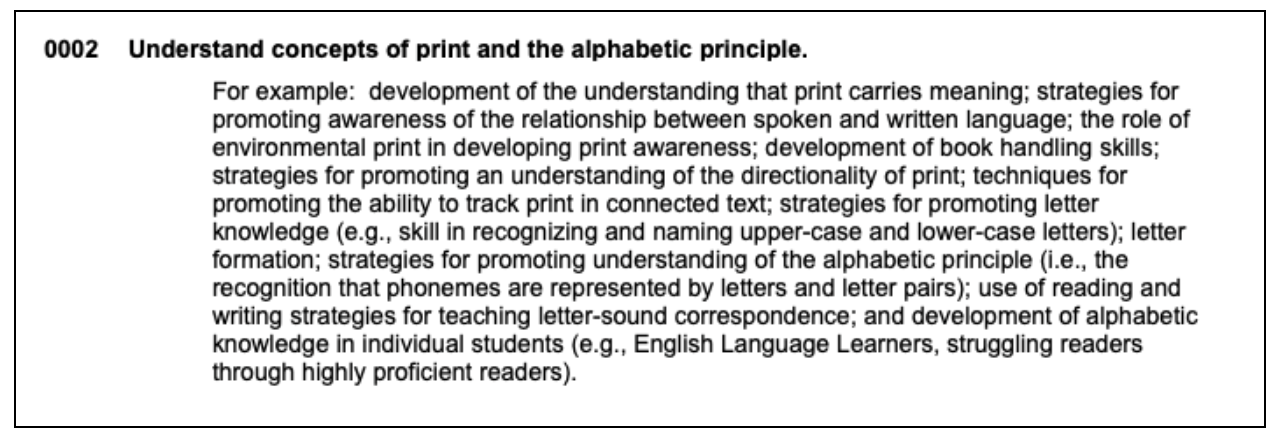
This section tests your knowledge on the concepts of print and the alphabetic principle. This includes knowing how to help students:
- understand that print carries meaning
- be aware of the relationship between spoken and written words
- understand the role of environmental print
- display book handling skills
- track print
- recognize and name upper- and lower- case letters
- recognize sounds
Here are some concepts that you may see on the test.
Environmental Print
Environmental print is the print of everyday life. It’s what we call print that appears on signs, labels, and logos. For many children learning to read, environmental print helps form a connection between letters and sounds. For example:
A child who sees the McDonald’s sign recognizes the giant “M” and makes a connection between the letter M and the first sound in the name McDonald’s.
Alphabetic Principle
Alphabetic principle is the idea that letters and letter patterns represent the sounds of spoken words in language. Once children understand this principle and learn the relationships between sounds and letters, they are able to read with much greater fluency. For example:
The word cat
is made with the sounds /cccc/ /aaaa/ and /tttt/.
Tracking
Tracking is the ability to read and write from left-to-right. The way the English language is organized (left-to-right) is an important component of written language. Children who track properly will look at AND process letters and words in order from left-to-right. This skill is essential for reading, because if students are not tracking properly, letters will not have the correct relationships, and sentences will lose their meaning.
This section tests your knowledge on the concepts of print and the alphabetic principle. This includes knowing how to help students:
- understand that print carries meaning
- be aware of the relationship between spoken and written words
- understand the role of environmental print
- display book handling skills
- track print
- recognize and name upper- and lower- case letters
- recognize sounds
Here are some concepts that you may see on the test.
Environmental Print
Environmental print is the print of everyday life. It’s what we call print that appears on signs, labels, and logos. For many children learning to read, environmental print helps form a connection between letters and sounds. For example:
A child who sees the McDonald’s sign recognizes the giant “M” and makes a connection between the letter M and the first sound in the name McDonald’s.
Alphabetic Principle
Alphabetic principle is the idea that letters and letter patterns represent the sounds of spoken words in language. Once children understand this principle and learn the relationships between sounds and letters, they are able to read with much greater fluency. For example:
The word cat
is made with the sounds /cccc/ /aaaa/ and /tttt/.
Tracking
Tracking is the ability to read and write from left-to-right. The way the English language is organized (left-to-right) is an important component of written language. Children who track properly will look at AND process letters and words in order from left-to-right. This skill is essential for reading, because if students are not tracking properly, letters will not have the correct relationships, and sentences will lose their meaning.
Phonics
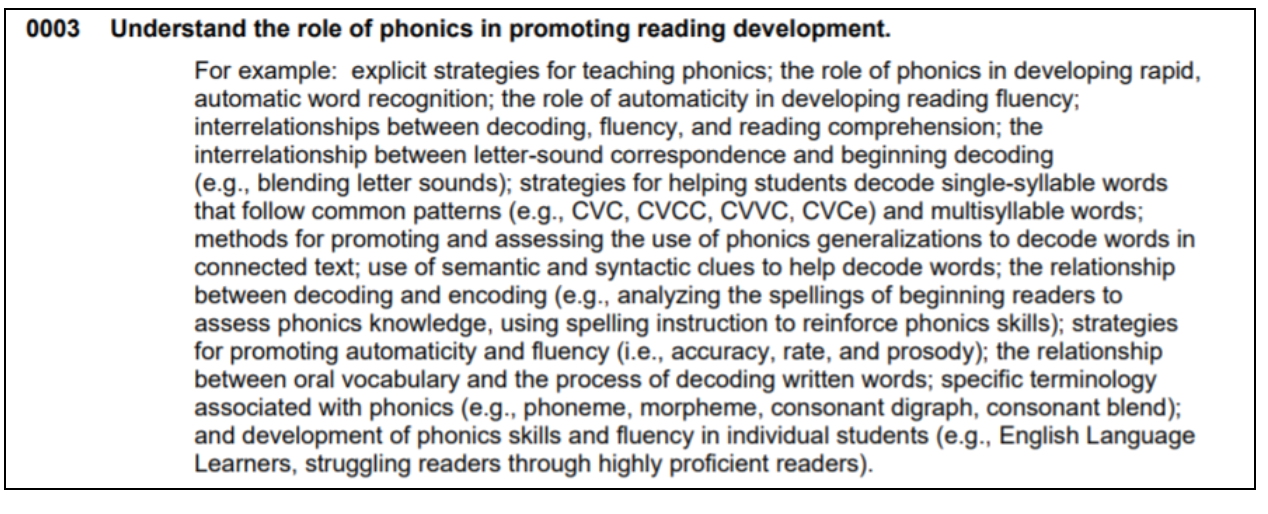
This section tests your knowledge on the role of phonics in promoting reading development. This includes but is not limited to:
- knowing specific teaching strategies for phonics instruction
- developing word recognition
- increasing automaticity
- knowing the relationships between decoding, fluency, and comprehension
- blending letter sounds
- knowing common patterns for single-syllable words
- differentiating phonics instruction for ELLs, struggling readers, and strong readers
Let’s look at some concepts that are guaranteed to come up on the test.
Automaticity
Automaticity is the ability to
quickly
AND
accurately
identify words. Automaticity develops more and more as children read. It does not include reading with expression and is not the same thing as reading fluency. Automaticity is necessary for developing fluency so that children can read with better expression and more fluidly.
Decoding versus Encoding
- Decoding is converting symbols (letters) to sounds in spoken language.
- Encoding is converting sounds to symbols (letters/words) in written language.
Decoding and encoding rely on a student’s phonological awareness which includes their understanding of sounds, letters, and how both work together to create spoken and written language.
Fluency
Fluency is the ability to read a text accurately, quickly, and with expression. Fluency is important because it provides a bridge between recognizing a word and comprehending the meaning and context of the word.
Here are the components of fluency:
- accuracy- reading words correctly
- automaticity- reading words quickly AND accurately
- prosody- reading words/phrases with appropriate expression
Let’s take a look at some effective strategies for fluency instruction:
- Record students reading aloud on their own.
- Ask students to track (using a ruler or finger) while you read aloud.
- Provide opportunities for students to re-read text several times.
- Pre-teach vocabulary.
- Drill sight words.
- Provide a variety of books and materials to read.
- Consistently read aloud to students.
Common Word Patterns
Word patterns are predictable patterns of sounds (consonants and vowels) that form words.
For example:
CVC- A consonant is followed by a vowel and another consonant to create a syllable, usually with a short vowel sound (
bat, top, kid
).
CVCe- Same as above, but a silent
e
is found at the end of the word. This usually makes the vowel of the word long (
hike, tone, make
).
CVCC- Here you have words that end with two consonants (
cart, best, half
).
Understanding word patterns strengthens a child’s phonological and phonemic awareness which, in turn, strengthens a child’s reading fluency.
This section tests your knowledge on the role of phonics in promoting reading development. This includes but is not limited to:
- knowing specific teaching strategies for phonics instruction
- developing word recognition
- increasing automaticity
- knowing the relationships between decoding, fluency, and comprehension
- blending letter sounds
- knowing common patterns for single-syllable words
- differentiating phonics instruction for ELLs, struggling readers, and strong readers
Let’s look at some concepts that are guaranteed to come up on the test.
Automaticity
Automaticity is the ability to
quickly
AND
accurately
identify words. Automaticity develops more and more as children read. It does not include reading with expression and is not the same thing as reading fluency. Automaticity is necessary for developing fluency so that children can read with better expression and more fluidly.
Decoding versus Encoding
- Decoding is converting symbols (letters) to sounds in spoken language.
- Encoding is converting sounds to symbols (letters/words) in written language.
Decoding and encoding rely on a student’s phonological awareness which includes their understanding of sounds, letters, and how both work together to create spoken and written language.
Fluency
Fluency is the ability to read a text accurately, quickly, and with expression. Fluency is important because it provides a bridge between recognizing a word and comprehending the meaning and context of the word.
Here are the components of fluency:
- accuracy- reading words correctly
- automaticity- reading words quickly AND accurately
- prosody- reading words/phrases with appropriate expression
Let’s take a look at some effective strategies for fluency instruction:
- Record students reading aloud on their own.
- Ask students to track (using a ruler or finger) while you read aloud.
- Provide opportunities for students to re-read text several times.
- Pre-teach vocabulary.
- Drill sight words.
- Provide a variety of books and materials to read.
- Consistently read aloud to students.
Common Word Patterns
Word patterns are predictable patterns of sounds (consonants and vowels) that form words.
For example:
CVC- A consonant is followed by a vowel and another consonant to create a syllable, usually with a short vowel sound (
bat, top, kid
).
CVCe- Same as above, but a silent
e
is found at the end of the word. This usually makes the vowel of the word long (
hike, tone, make
).
CVCC- Here you have words that end with two consonants (
cart, best, half
).
Understanding word patterns strengthens a child’s phonological and phonemic awareness which, in turn, strengthens a child’s reading fluency.
Word Analysis
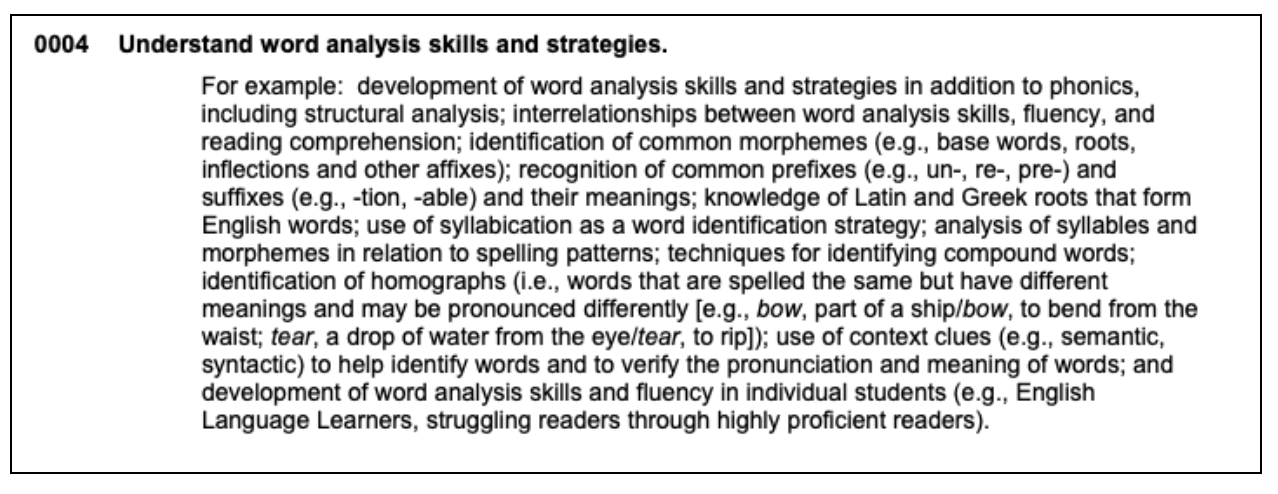
This section tests your knowledge of word analysis skills and strategies. This includes but is not limited to:
- identification of common morphemes
- recognition of common prefixes and their meanings
- analysis of spelling patterns
- identification of compound words and homographs
- use of context clues to pronounce/identify multiple-meaning words
- development of word analysis skills in ELL’s, struggling readers, and strong readers
Here are some specific concepts that will more than likely appear on the test.
Context Clues
Context clues are the part of reading comprehension that involves using the other words in a sentence or passage to understand an unknown word or words. Usually, a writer will include hints to help the reader understand the meaning of the word or phrase. When children use context clues to help them identify words, they use pictures or sentence context. For example:
Kate put her glasses on.
This sentence would probably be on the same page with a picture of Kate putting her glasses on. A child may not recognize the word
glasses
, but the picture helps with identifying the unknown word.
Syllabication
Syllabication is the division of words into syllables; this makes unfamiliar words easier to read. It is important to remember that a syllable has a vowel sound, so each syllable will contain a vowel. For example, the word
grumble
has two vowels (u,e) and can be broken into two syllables:
grum/ble
Homographs
A
homograph
is a word that has the same spelling as another word but has a different sound and a different meaning.
For example:
- lead(to go in front of) and lead(a metal)
- wind(to follow a course that is not straight) and wind(a gust of air)
- bass(low, deep sound) and bass(a type of fish)
It is really important for students to use context clues to decipher the intended meaning of a homograph.
And that’s some basic info about Subarea I: Foundations of Reading
Development.
Now, let’s look at a few practice questions in each area to see how these
concepts might actually appear on the real test.
This section tests your knowledge of word analysis skills and strategies. This includes but is not limited to:
- identification of common morphemes
- recognition of common prefixes and their meanings
- analysis of spelling patterns
- identification of compound words and homographs
- use of context clues to pronounce/identify multiple-meaning words
- development of word analysis skills in ELL’s, struggling readers, and strong readers
Here are some specific concepts that will more than likely appear on the test.
Context Clues
Context clues are the part of reading comprehension that involves using the other words in a sentence or passage to understand an unknown word or words. Usually, a writer will include hints to help the reader understand the meaning of the word or phrase. When children use context clues to help them identify words, they use pictures or sentence context. For example:
Kate put her glasses on.
This sentence would probably be on the same page with a picture of Kate putting her glasses on. A child may not recognize the word
glasses
, but the picture helps with identifying the unknown word.
Syllabication
Syllabication is the division of words into syllables; this makes unfamiliar words easier to read. It is important to remember that a syllable has a vowel sound, so each syllable will contain a vowel. For example, the word
grumble
has two vowels (u,e) and can be broken into two syllables:
grum/ble
Homographs
A
homograph
is a word that has the same spelling as another word but has a different sound and a different meaning.
For example:
- lead(to go in front of) and lead(a metal)
- wind(to follow a course that is not straight) and wind(a gust of air)
- bass(low, deep sound) and bass(a type of fish)
It is really important for students to use context clues to decipher the intended meaning of a homograph.
And that’s some basic info about Subarea I: Foundations of Reading
Development.
Now, let’s look at a few practice questions in each area to see how these
concepts might actually appear on the real test.
Subarea II: Development of Reading Comprehension
Subarea II accounts for about 27% of the multiple-choice section of the exam.
This subarea has three objectives:
- Vocabulary
- Comprehension and Imaginative/Literary Texts
- Comprehension and Informational/Expository Texts
So, let’s start with Vocabulary.
Vocabulary
This section tests your knowledge on vocabulary development. This includes but is not limited to:
- knowing the relationship between oral and written vocabulary development
- understanding common sayings including idioms and proverbs
- knowing foreign words and commonly used abbreviations
- understanding strategies for promoting comprehension across curriculum by expanding knowledge of academic vocabulary
Let’s discuss some concepts that will more than likely appear on the test.
Word Maps
A word map is a way to visually organize vocabulary that specifically promotes vocabulary development. Word maps aid in students’ vocabulary development because they encourage the students to think about vocabulary terms and concepts in several ways. They also help students build on prior knowledge, as well as visually represent new information.
Most word maps require students to:
- define the word
- list synonyms and antonyms for the word
- draw a picture to represent the word or concept
Here is an example of a word map:
Academic Vocabulary
Academic vocabulary refers to words that are commonly used in the classroom. These types of words are used to explain a concept but are not typically used in non-academic conversations.
Here are some examples of academic vocabulary:
- analyze
- structure
- category
- conclude
- illustrate
- contrast
- label
- summarize
- cite
Oral Language Development
Oral language is the system through which we use words to express what we know, our ideas, and our feelings. Developing oral language in young children is vital to their success as readers. Listening and speaking skills have a strong relationship to writing and reading comprehension.
Here are the components of oral language:
- phonological skills- the awareness of sounds
- pragmatics- understanding the social norms of communication
- syntax- understanding word order and grammar rules
- morphological skills- understanding the meaning of word forms and parts
- vocabulary (semantics)- understanding the meaning of words and phrases
Let’s look at the 5 stages of oral language development:
- silent/receptive- children are listening to but not using the language
- early production- children will begin using short phrases with many errors and will acquire up to 1,000 words
- speech emergence- children will acquire even more words and will begin to use phrases more confidently and with fewer grammatical errors
- intermediate fluency- children begin to communicate in written form, as well as develop more complex sentences
- advanced fluency- children will demonstrate mastery of written and spoken language; they need frequent opportunities to express themselves in writing, as well as in spoken language to maintain their language skills
Now, here are some strategies for promoting oral language development:
- encourage conversation; provide students the opportunity to practice the language skills you are teaching
- provide direct phonological awareness instruction
- provide students with a wide range of print materials; students who are exposed to a variety of print materials develop oral language more quickly
- expose students to language as often as possible
Comprehension and Imaginative/Literary Texts
This section tests your knowledge of how to apply reading comprehension skills and strategies to imaginative/literary texts including but not limited to:
- types of comprehension
- story elements
- literary allusions
Let’s take a look at these concepts.
Types of Comprehension
One of the common reading comprehension models proposes that there are three types or levels of comprehension:
- literal comprehension- understanding text in the most basic sense; understanding the meaning of the words, the context, the main idea, and the sequence of events
- inferential comprehension- understanding the undisclosed meaning of text then using that meaning to make inferences
- evaluative comprehension- understanding to the extent of being able to provide a response based on the reader’s opinion
Each type of reading comprehension is important because a reader needs all three in order to truly comprehend what he/she is reading.
Story Elements
Here are the five story elements of fictional text:
- characters- the participants in the story
- setting- when and where the story takes place
- plot- the storyline or main events
- conflict- the problem of the story
- resolution- how the problem is solved
These elements hook the reader’s attention, keep the story flowing, and allow for a logical sequence of events.
One of the best ways to teach story elements is to point them out while reading to your students. It is important to “think out loud” and model for your students as you identify the different story elements.
You can also ask students to identify each element in the fiction books they are reading; try challenging students to write their own stories with story elements.
Literary Allusions
Literary allusions are used by authors to make an indirect reference to an event or figure. Most often, allusions are made to past events or figures. For example:
You’re a regular Einstein.
This allusion references a famous scientist and mathematician whom a reader would need to know in order for the statement to make sense.
Here’s another one:
He was a real Romeo with the ladies.
This allusion references Shakespeare’s famous
Romeo and Juliet
to describe someone who is romantic.
Comprehension and Informational/Expository Texts
This section tests your knowledge of applying reading skills to informational texts including but not limited to:
- fact vs. opinion
- text features
- text structures
Let’s discuss some concepts that may appear on the test.
Fact versus Opinion
A fact is a statement that can be proven true. An opinion is an expression of a person’s feelings that cannot be proven. Factual statements do not include signal words, but many times, opinion statements do. Examples of common signal words for opinion statements include:
good/bad, might, believe, should, always/never, guess
Teaching these signal words to students helps them determine if a statement is a fact or opinion. For example:
Fact:
The sky was blue on Monday.
Opinion:
The sky was the most beautiful shade of blue on Monday.
Text Features
A text feature is anything that is not the main body of text. Here are the common text features of informational/expository text:
- title- tells the reader what he/she will be learning about
- table of contents- shows the reader different sections and where to find each one
- index- tells the reader where to find specific names, subjects, etc.
- glossary- defines important vocabulary
- headings/subtitles- helps the reader identify the main idea for each section
- pictures/captions- highlights an important idea from the text
- labeled diagrams/charts/graphs- reinforces important information/data from the text
- maps- helps the reader understand the context of the text by understanding the location
Text Structures
Text structure refers to how a piece of text is organized. Teaching students to recognize common text structures helps students not only monitor their level of comprehension but also understand the main idea and details of a given text.
Here are the common text structures for expository text:
- description-
describes
a certain topic
- sequence-
lists events
in sequential order
- problem and solution-
poses a problem and suggests a solution
- cause and effect- presents the
relationship
between a specific event or idea and the events that follow
- compare and contrast- focuses on the
similarities and differences
between two or more people, places, ideas, events, etc.
And that’s some basic info about Subarea II: Development of Reading
Comprehension.
Now, let’s look at a few practice questions in each area to see how these
concepts might actually appear on the real test.
Subarea III: Reading Assessment and Instruction
Subarea III accounts for about 18% of the multiple-choice section of the exam.
This subarea has two objectives:
- Assessment Methods
- Reading Instruction
So, let’s start with Assessment Methods.
Assessment Methods
This section tests your knowledge on using formal and informal methods for assessing reading development. This includes but is not limited to:
- running records
- reading level assessments
Here are some concepts that may appear on the test.
Norm-Referenced versus Criterion-Referenced Assessments
A norm-referenced assessment compares a student’s score to that of their peers. This type of assessment is
typically reported in percentiles
that detail how a student scored in relation to the rest of their peers. The results will not be in pass/fail format.
A criterion-referenced assessment assigns a
specific score
to a student’s performance on a grade-level standard. The goal of this type of assessment is to
determine mastery of a specific skill.
The results will usually be “pass” (met standard) or “fail” (did not meet standard).
Running Record
A running record is a way to assess a student’s reading level. While a student reads aloud, the teacher listens and assesses fluency and identifies error patterns.
There are a few different systems for taking running records. Most require the teacher to provide a student with a specific, leveled passage then listen to the child read aloud for a set amount of time. While the student reads, the teacher keeps a record of mistakes and takes notes. This data provides insight into fluency (accuracy, automaticity, prosody).
Keeping record of students’ reading progress will help you continually evaluate your students’ strengths and weaknesses, so you can provide intentional and targeted reading instruction.
For an example of a running record, as well as how to score a running record, check out this resource: https://www.readinga-z.com/helpful-tools/about-running-records/marking-a-running-record/
Reading Levels
Students will read a text on one of three levels:
- independent- the text is not challenging for the student to read; the student makes few to no errors when reading this text (95-100% accuracy); it is the highest level you would expect a child to read with little to no help
- instructional- the student will have some background knowledge of the topic and can read the text fluently with minimal support and errors (90-95% accuracy)
- frustrational- the topic of the text is unfamiliar to the student due to a lack of background knowledge; the student makes multiple errors (less than 90% accuracy) while reading and requires moderate to intensive support
The best way to monitor a student’s reading level is to assess it frequently. This involves:
- taking running records
- listening to the student read
- tracking fluency
- asking questions about the text (to monitor a student’s comprehension)
Students may have a different reading level for fiction text and informational text due to a lack of background knowledge needed for the latter.
Reading Instruction
This section tests your knowledge of the multiple approaches to reading instruction. This includes but is not limited to:
- flexible grouping
- text complexity
- differentiation
Let’s discuss some concepts that may appear on the test.
Flexible Grouping
Flexible grouping is an instructional strategy that divides students into groups based on different factors that are determined by the teacher. Using common sense when grouping is important, and a teacher should always choose the most effective method to deliver instruction.
Flexible groups can be:
- student or teacher-led
- organized according to skill level or need
- varied in size
- cross-class or cross-grade level
Flexible grouping provides students with the opportunity to work with other students, but it also provides teachers with the opportunity to deliver specific and differentiated instruction to a targeted group of students.
Text Complexity
Text complexity is a system that determines how challenging a text is for a child at their specific grade level.
Three factors are used to determine the complexity of the text:
- qualitative measures- text structure, language clarity, knowledge demands, and levels of meaning
- quantitative measures- generally measured by Lexile level
- reader and task- interest, motivation, and background knowledge of a reader
*Each factor is rated on the basis of grade-level appropriateness.
Students will read through a text sequence, and as they do so, they will acquire vocabulary as well as gain a deeper comprehension of more difficult texts in a given set. Sequenced texts are a great tool for teachers to use so that students are able to progress in a way that is clear and beneficial to their overall fluency and reading development.
Differentiation
Differentiation is an effort by a teacher to meet the individual needs of each student in his/her class. Students enter classrooms with varying levels of proficiency; it is important to teach to each individual student.
Teachers can differentiate by adjusting:
- content- what the student is expected to learn (leveled reading materials, spelling lists, reading buddies, small group instruction, etc.)
- process- activities that support students acquiring the content (passion projects, leveled activity centers, offering manipulatives, etc.)
- expected products- the way students demonstrate mastery of the content (create a puppet show, write a poem, allow students to work independently or in a group, etc.)
- learning environment- the way the classroom is set up (providing spaces for group and independent work, establishing routines, allowing students to sit where they learn best, providing materials that represent various cultures/backgrounds, etc.)
And that’s some basic info about Subarea III: Reading Assessment and
Instruction.
Now, let’s look at a few practice questions in each area to see how these
concepts might actually appear on the real test.
Subarea IV: Integration of Knowledge and Understanding
Subarea IV accounts for about 20% of the multiple-choice section of the exam.
The open-ended response portion of the test contains two written assignments. It is important that you read and respond to each part of the question and record your response as instructed. Also, be sure to read the background information given to you and attempt to use specific terms from the question.
Let’s say you are given a scenario where a third-grade student has read a passage aloud, and his teacher is taking a running record. You are shown an example of the running record and are asked to:
“Use your knowledge of word identification strategies, and identify one of Jonathan’s strengths and one of his weaknesses.”
Be sure to:
- cite specific evidence from the information you were given
- demonstrate an understanding of the field
- demonstrate the depth of your understanding of the subject area (reading instruction)
- NOT simply recite factual information
Your responses will be evaluated based on the following criteria:
- Purpose:the extent to which the response achieves the purpose of the assignment
- Subject knowledge:appropriateness and accuracy in the application of subject knowledge
- Support:quality and relevance of supporting evidence
- Rationale:soundness of argument and degree of understanding of the subject area

